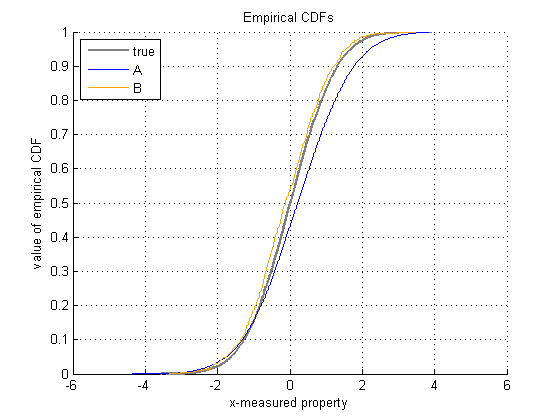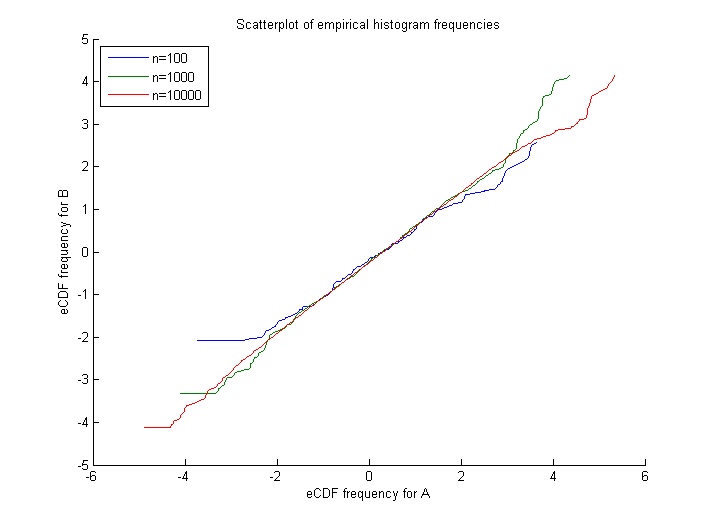I have two different measuring instruments, A and B, both measure the same physical property $x$ of an object but with different "quality": B gives measurements with a known uncertainty while I do not know the uncertainty in the measurements given by A.
I have $N$ distinct objects and I measure the property $x$ for all of them with A, so I get a list of measurements $L_A=\{x_{A1}, x_{A2},\ldots,x_{AN}\}$ where $x_{Ai}$ is the measurement of the property $x$ for the $i$-th object.
The objects are not labeled so, given an object, I just know that its measurement belongs to $L_A$ but I am not able to extract the measurement from $L_A$. Furthermore, I cannot use A to measure an object that I have already measured in the past with A.
Then I randomly choose $M \lt N$ objects from the $N$ objects. I measure all the $M$ objects of the sample with B and I get a list of measurements $L_B=\{x_{B1}, x_{B2},\ldots,x_{BM}\}$. Please note that the index in the subscript is not a label for the object so I cannot directly compare $x_{A1}$ with $x_{B1}$.
Is it possible to estimate the uncertainty in the measurements given by A with the above data?
I was thinking about comparing the empirical cumulative distribution function of $L_A$ with the one of $L_B$ but it is just an idea and I am not able to elaborate it further.
Is there any established standards which cover my problem? For example I found references to "ISO 5725: Accuracy (trueness and precision) of measurement methods and results" but I have not access to it.
Update:
I found my question similar to How to test if reading from two devices are significantly different? where I read the answer by Michael Lew, he suggests the paper LUDBROOK, John. Statistical techniques for comparing measurers and methods of measurement: a critical review. Clinical and Experimental Pharmacology and Physiology, 2002, 29.7: 527-536. but unfortunately it seems to me that the paper requires the pairing between the measurements.
Update 2:
I have written an R script to simulate my problem.
set.seed(42)
instrument_measurement <- function(true_value,gain,offset,dispersion)
# The instrument has three parameters: the true_value is transformed by means
# of a linear transformation described by parameters offset and gain; then there
# is a dispersion parameter. An ideal instrument would have gain=1, offset=0
# and dispersion that approaches to zero.
{
return(rnorm(length(true_value),mean=gain*true_value-offset,sd=dispersion))
}
N=1000
true_mean = 0
true_sd = 1
# I simulate the property to be measured for N objects, here the property is
# normally distributed...
true_values = rnorm(N,mean=true_mean,sd=true_sd)
# but it could also be a mixture of normal distributions:
# components <- sample(1:3,prob=c(1/7,5/7,1/7),size=N,replace=TRUE)
# mus <- c(-0.2,0,+0.3)
# sds <- sqrt(c(0.05,0.05,0.05))
# true_values <- rnorm(n=N,mean=mus[components],sd=sds[components])
# plot(density(true_values))
# The "quality" of instrument B is "good enough" to measure the true values:
gain_B = 1
offset_B = true_sd/10
dispersion_B = true_sd/10
# The instrument B has a lower "quality" than the one of instrument A:
gain_A = 1.1*gain_B
offset_A=-2*offset_B
dispersion_A=5*dispersion_B
# I simulate the measuremente made by instrument A:
L_A = instrument_measurement(true_values,gain_A,offset_A,dispersion_A)
# I make the sample:
sample_to_measure_with_B = sample(true_values,100,replace=F)
# I simulate the measuremente made by instrument B:
L_B = instrument_measurement(sample_to_measure_with_B,gain_B,offset_B,dispersion_B)
# I plot the empirical CDF of the true values, of the measurements made with
# instrument A and of the measurements made with instrument B
plot(ecdf(true_values),col="grey",main="",xlab="x, measured property",ylab="value of empirical CDF")
lines(ecdf(L_A),col="blue")
lines(ecdf(L_B),col="orange")
legend(x=(max(true_values)+mean(true_values))/2,y=.5,legend=c("true","A","B"),col=c("grey","blue","orange"),lty=c(1,1,1))
title("Empirical CDFs")
Referring to the script, is is possible to estimate gain_A, offset_A and dispersion_A from L_A and L_B? What would be the uncertainties in the estimates?
I had an inelegant idea of defining a cost function and try to minimize it in the space of the parameters gain, offset and dispersion:
function <- ecdf_distance(ecdf1,ecdf2)
{
# return 0 if ecdf1 is "equal" to ecdf2
# return a positive scalar that measures the difference between ecdf1 and ecdf2
}
function <- cost(parameters)
{
L = instrument_measurement(L_B,parameters$gain,parameter$offset,parameter$dispersion)
return(ecdf_distance(ecdf(L_A),ecdf(L))
}
I made some test keeping gain=1 but with no luck... the cost function seems constant with respect to dispersion... I am afraid I lack some theory/math about the problem :-)




